Jotunn: The Giants of Norse Mythology
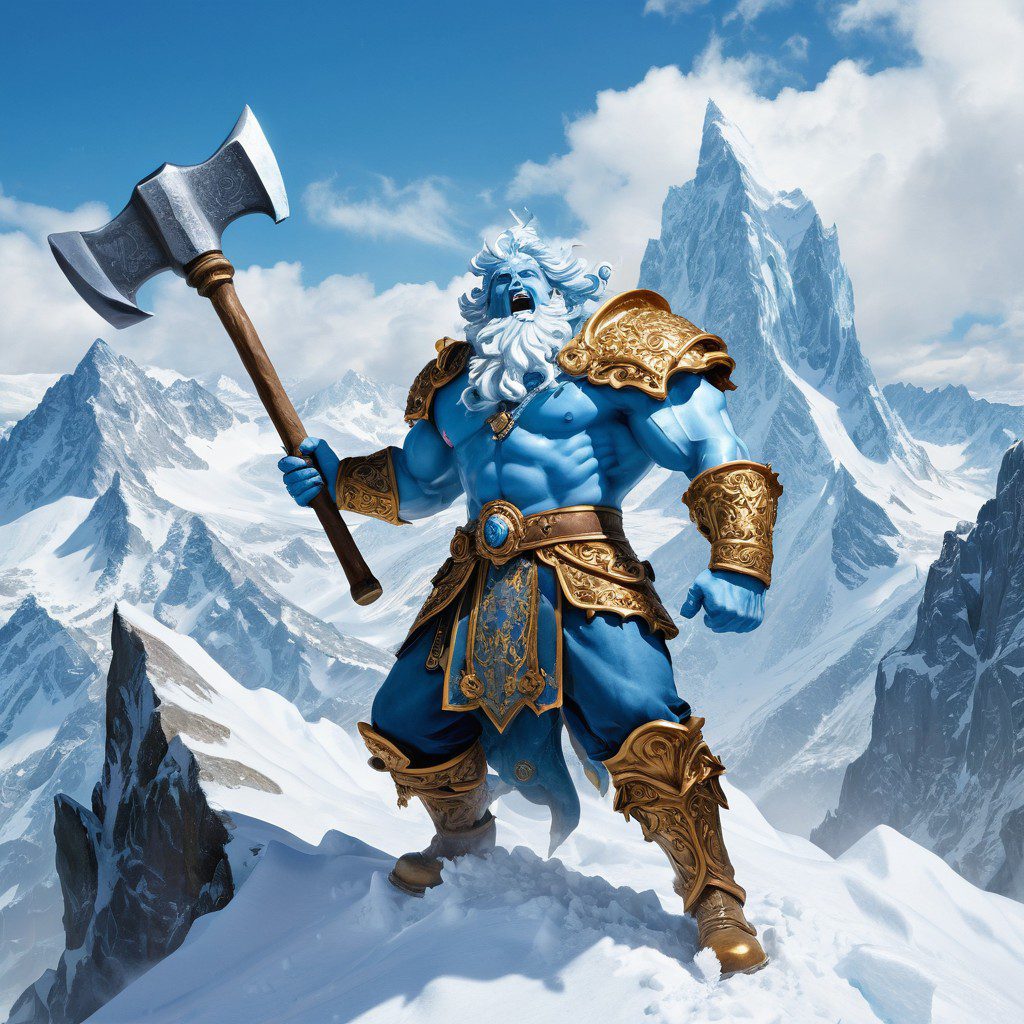
The Jötnar (singular Jotunn), also known as the giants of Norse mythology, are one of the most powerful and enigmatic races in the Norse cosmos. Though they are commonly referred to as giants, their role in mythology is far more complex than their size suggests. The Jötnar represent primal forces of nature, chaos, and destruction, but they are also vital contributors to the creation of the world and its balance. They often stand in opposition to the gods, particularly the Aesir, but they are not strictly enemies. Many Jötnar intermarry with the gods, and some are even counted among their ranks.
From their home in Jotunheim, the land of giants, the Jötnar serve as antagonists, allies, and even cosmic threats, embodying forces that exist outside the structured order the gods seek to maintain. Let’s dive into the lore, cultural significance, and modern interpretations of the Jötnar in Norse mythology.
Origins and Nature of the Jötnar
The origins of the Jötnar can be traced back to the primordial giant Ymir, whose body was used by the gods to create the world. According to Snorri Sturluson’s Prose Edda and the Poetic Edda, Ymir was the first being, born from the collision of fire from Muspelheim and ice from Niflheim. He produced the first of the Jötnar from the sweat of his armpits and from his legs. This lineage of giants continued to grow, establishing the race of Jötnar as ancient and fundamentally tied to the forces of nature.
The Jötnar represent untamed chaos and elemental forces that oppose the order of the gods. However, they are not uniformly evil or destructive; their relationships with the gods are nuanced, with some Jötnar cooperating with the Aesir and Vanir, while others act as adversaries. They live in Jotunheim, one of the nine realms of the Norse cosmos, and this land is depicted as a wild and harsh place, full of challenges, danger, and beauty.
Characteristics of the Jötnar
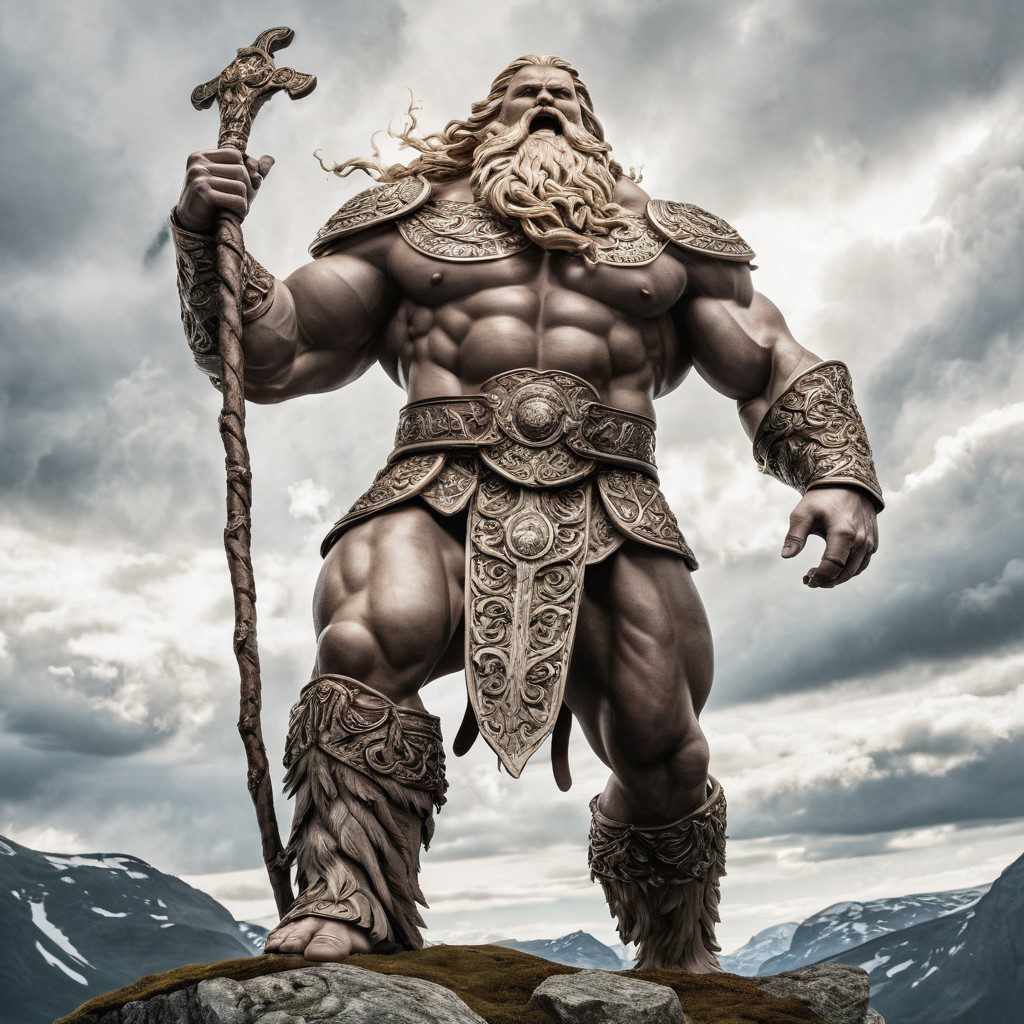
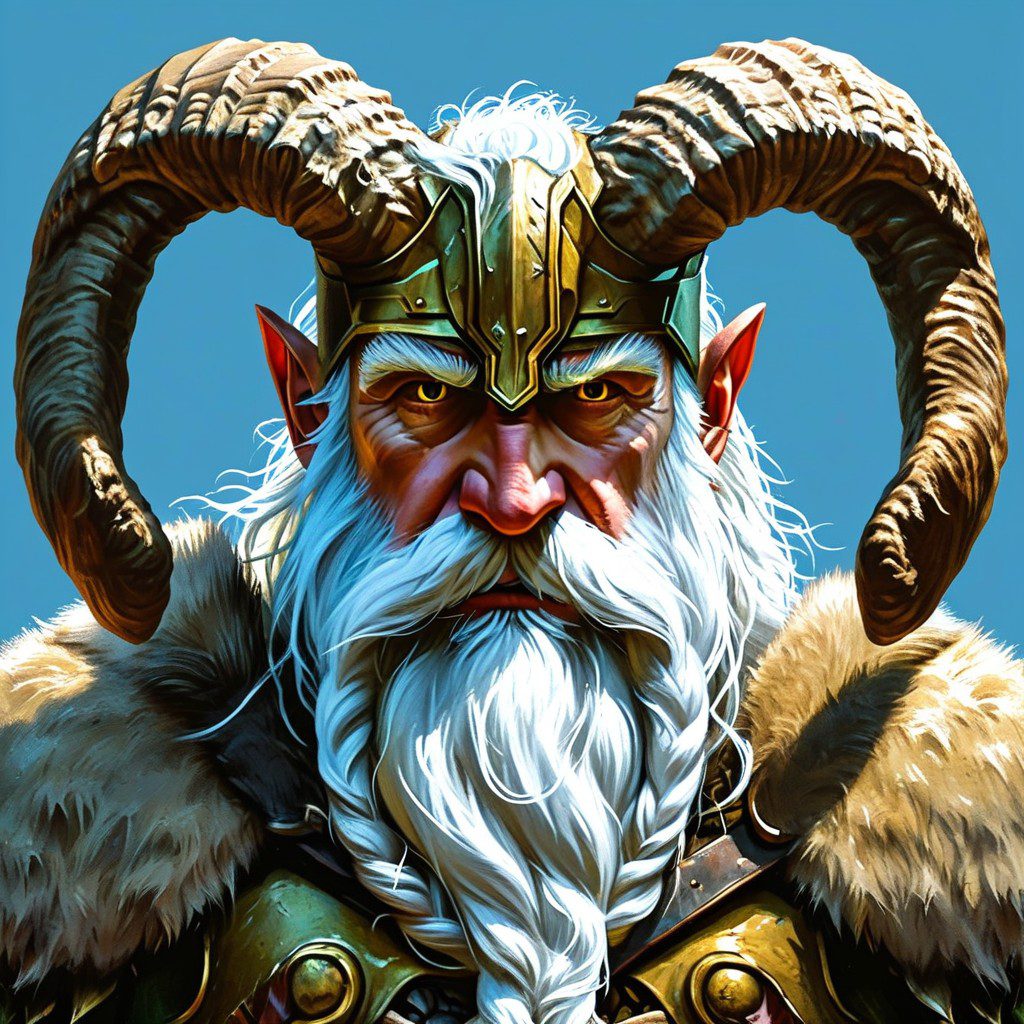
Despite being referred to as giants, the Jötnar in Norse mythology are not all uniformly massive in size. Some are indeed colossal, but others resemble humans in stature or even take on different forms. The term “giant” refers more to their elemental nature and their position outside the divine order, rather than simply their physical size.
Physical Traits:
- Jötnar are often depicted as towering figures with immense strength, but they can also shape-shift, taking on different forms, including animals or even gods. Some are grotesque and terrifying, while others are described as beautiful or alluring, particularly female Jötnar, who often marry gods like Odin or Thor.
Elemental Nature:
- The Jötnar are deeply connected to natural forces, particularly destructive elements like ice, fire, and storms. They embody both the raw power and beauty of nature. Frost giants, for example, represent the harshness of winter, while fire giants are tied to the scorching, chaotic fires of Muspelheim, ruled by the terrifying Surtr.
Major Jötnar in Norse Mythology
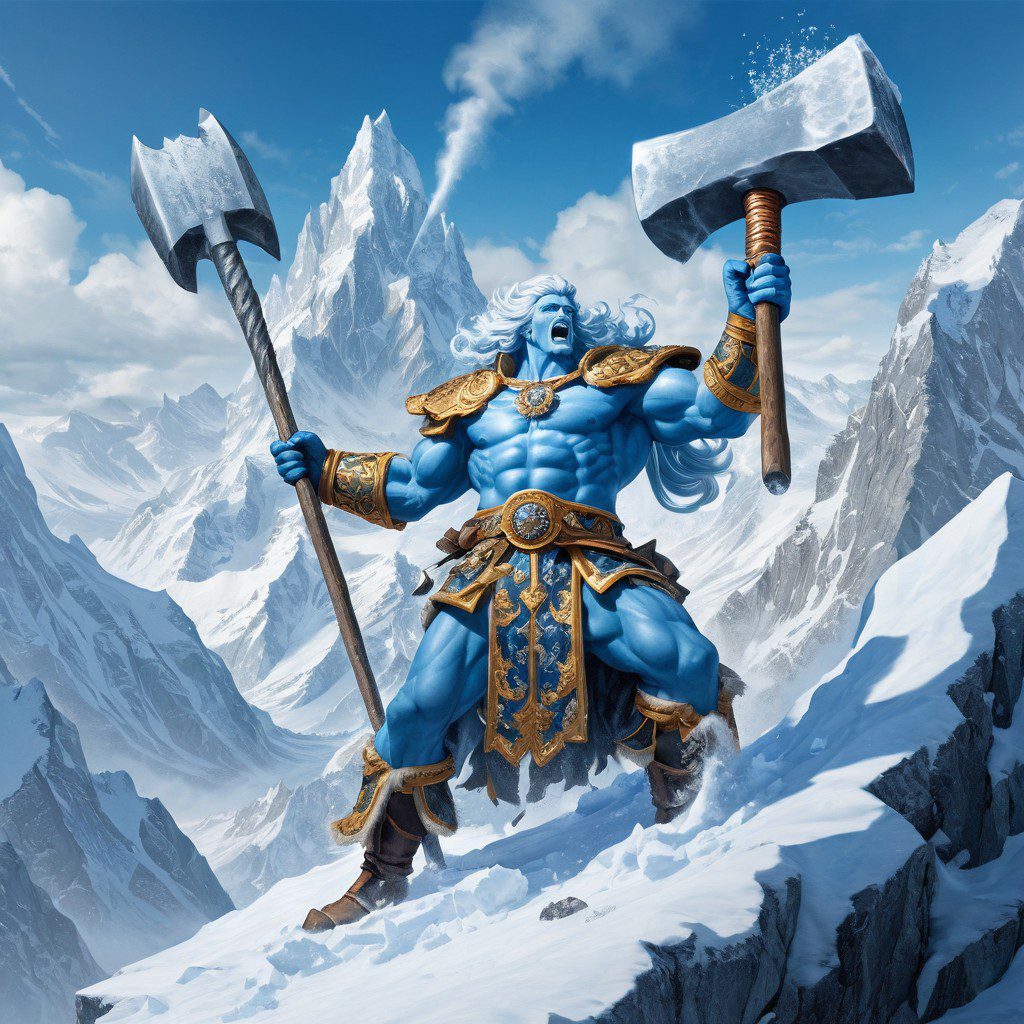
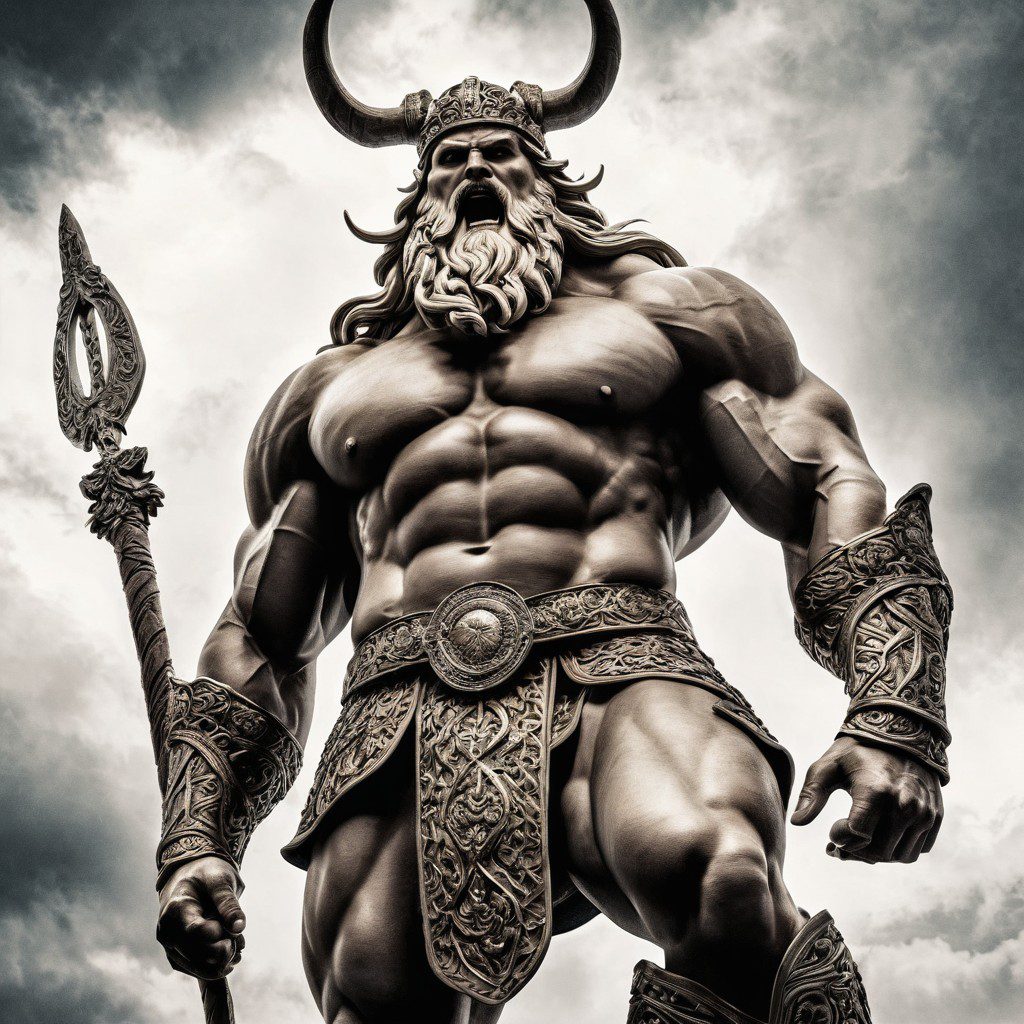
Several Jötnar are particularly important in Norse myth, often playing pivotal roles in the myths surrounding creation, cosmic battles, and the inevitable end of the world.
1. Ymir
Ymir is the primordial being from whom all Jötnar are descended. His death at the hands of Odin, Vili, and Vé marks the beginning of the cosmos, as his body is used to create the world. His blood becomes the oceans, his flesh the land, his bones the mountains, and his skull the sky. Ymir’s role as the original giant underscores the Jötnar’s deep connection to the natural world.
2. Surtr
Surtr is the fire giant who resides in Muspelheim, the realm of fire. He plays a crucial role in the events of Ragnarök, the end of the world. Wielding a flaming sword, Surtr is prophesied to lead the forces of chaos against the gods, setting the world ablaze. After defeating Freyr in battle, he will engulf the world in flames, reducing everything to ashes before a new world rises from the ruins.
3. Skadi
Skadi is a Jötunn who becomes a goddess through her marriage to the god Njord. She is a powerful figure in her own right, associated with winter, mountains, hunting, and skiing. After her father, the giant Thjazi, is killed by the gods, Skadi demands vengeance but is instead offered a husband from among the gods as compensation. Her role as both a giantess and a goddess shows the complexity of Jötunn-god relations.
4. Thrym
Thrym is the king of the frost giants in one of the most famous myths involving the Jötnar. In the poem Þrymskviða from the Poetic Edda, Thrym steals Thor’s hammer, Mjölnir, and demands the goddess Freyja as his bride in exchange for its return. Thor and Loki devise a plan to trick Thrym by disguising Thor as Freyja. The scheme works, and Thor retrieves his hammer, using it to slay Thrym and his kin.
5. Loki
Loki, though often considered one of the Aesir, is actually half-Jötunn, as his mother is the giantess Laufey. His mixed heritage makes him an ambiguous figure, playing both sides in the conflict between gods and giants. Loki’s children—Fenrir (the wolf), Jörmungandr (the World Serpent), and Hel (queen of the underworld)—all have Jötunn blood, and they play central roles in Ragnarök. Loki’s Jötunn origins underscore his role as a trickster and destabilizer of the cosmic order.
The Jötnar and Ragnarök
The Jötnar are deeply tied to Ragnarök, the apocalyptic battle that marks the end of the world in Norse mythology. At Ragnarök, the Jötnar will align with Loki and other forces of chaos to battle the gods in a cataclysmic war that will destroy the cosmos. Key figures like Surtr, Fenrir, and Jörmungandr lead the charge, bringing death and destruction to the gods and the world itself.
- Fenrir: The giant wolf Fenrir, a son of Loki and the Jötunn Angrboda, plays a central role in Ragnarök. Prophecies foretold that Fenrir would break free from his chains and kill Odin, swallowing him whole in the final battle.
- Jörmungandr: The World Serpent, another child of Loki and Angrboda, is destined to battle Thor at Ragnarök. After a long and fierce fight, Thor will slay Jörmungandr but will only take a few steps before succumbing to the serpent’s poison and dying.
The destruction caused by the Jötnar in Ragnarök signifies not only the end of the gods’ reign but also the eventual renewal of the world. After the battle, a new, purified world will rise from the ashes, symbolizing the cyclical nature of Norse cosmology, where destruction and creation are eternally linked.
Relationships Between the Gods and Jötnar
The relationship between the Jötnar and the Aesir (the gods of Asgard) is one of both conflict and kinship. While many stories depict the Jötnar as adversaries of the gods, especially in the lead-up to Ragnarök, there are numerous examples of intermarriage and cooperation between the two races.
1. Intermarriage
Several key gods have Jötunn ancestry or marry Jötnar. Loki, as mentioned, is half-Jötunn and often plays both sides in the conflict between gods and giants. Odin himself has Jötunn blood, as his mother was the Jötunn Bestla. Thor, the mightiest of the gods, is known for slaying giants, yet his own mother is the Jötunn Jord (Earth). Additionally, Njord, the god of the sea, marries the giantess Skadi, further blurring the lines between the two races.
2. Frenemies
Many myths depict the gods and Jötnar as adversaries, but these relationships are not always purely hostile. Thor frequently battles giants, yet he also drinks with them, has Jötunn lovers, and travels to Jotunheim to test his strength. Loki, despite being part-Jötunn, is accepted into the Aesir’s ranks for much of his life, illustrating the complex relationships between the two groups.
Strengths and Weaknesses of the Jötnar
Strengths:
- Immense Strength and Power: The Jötnar are known for their colossal strength and elemental power, particularly those aligned with fire, ice, and nature.
- Connection to Nature: The Jötnar embody the untamed forces of nature—storms, mountains, fire, and ice. Their raw power reflects the natural world’s beauty and danger.
- Shape-Shifting Abilities: Many Jötnar, such as Loki, possess the ability to change their form, allowing them to navigate between the realms of gods, mortals, and their own chaotic domains.
- Role in Cosmic Balance: Despite their opposition to the gods, the Jötnar are crucial to maintaining the cosmic balance. Their presence ensures that the universe remains dynamic, with destruction necessary for renewal.
Weaknesses:
- Chaotic Nature: The Jötnar’s connection to chaos and destruction often puts them at odds with the forces of order, leading to their eventual downfall at Ragnarök.
- Vulnerability to the Gods: While powerful, the Jötnar are frequently outwitted or overpowered by the gods, particularly Thor, who is known for slaying giants.
- Divided Loyalties: Some Jötnar ally with the gods, while others oppose them. This division among their ranks can weaken their collective strength, especially when facing the unified forces of the Aesir and Vanir.
The Jötnar in Modern Media
The Jötnar, like many figures from Norse mythology, have been featured in a wide variety of modern media, particularly in literature, video games, and films that explore the myths of the Viking Age.
- Literature: In modern adaptations of Norse mythology, such as Neil Gaiman’s Norse Mythology or Rick Riordan’s Magnus Chase and the Gods of Asgard series, the Jötnar are portrayed as both powerful enemies and reluctant allies, staying true to their complex mythological roles.
- Video Games: In God of War (2018), the Jötnar are central to the plot, where the game’s protagonist, Kratos, and his son, Atreus, explore the Jötunn legacy. Similarly, in Assassin’s Creed: Valhalla, the Jötnar appear as important figures in the game’s depiction of the Norse mythological world.
- Film and TV: The Jötnar have appeared in several films and television shows that draw upon Norse mythology. In the Marvel Cinematic Universe, Loki’s Jötunn heritage is a key part of his character’s backstory, while the frost giants appear as enemies in Thor (2011). In the series Vikings, Norse mythological figures like the Jötnar influence the spiritual beliefs of the characters.
The Legacy of the Jötnar: Forces of Chaos and Creation
The Jötnar are far more than just giants in Norse mythology—they are embodiments of the wild, untamed forces of nature and chaos that existed before and alongside the gods. Though often depicted as antagonists, their role in maintaining cosmic balance is essential. Without the Jötnar, there would be no chaos to counterbalance the order of the gods, and the cyclical nature of creation and destruction would be incomplete.
In modern depictions, the Jötnar continue to represent the powerful, unpredictable forces that shape both the natural world and human experience. They are a reminder that chaos is not inherently evil but a necessary part of life’s ebb and flow, one that even the gods cannot escape.
